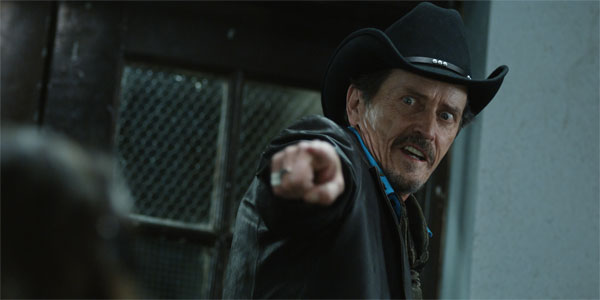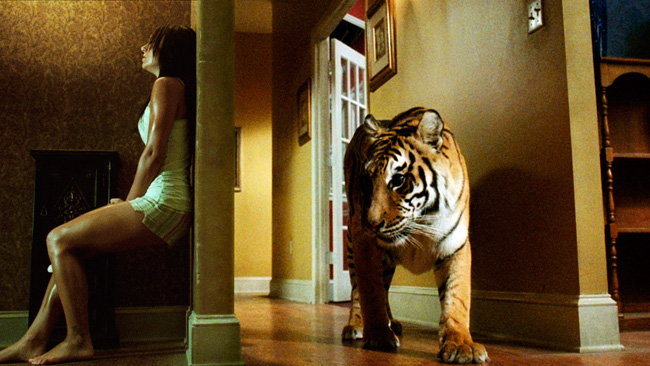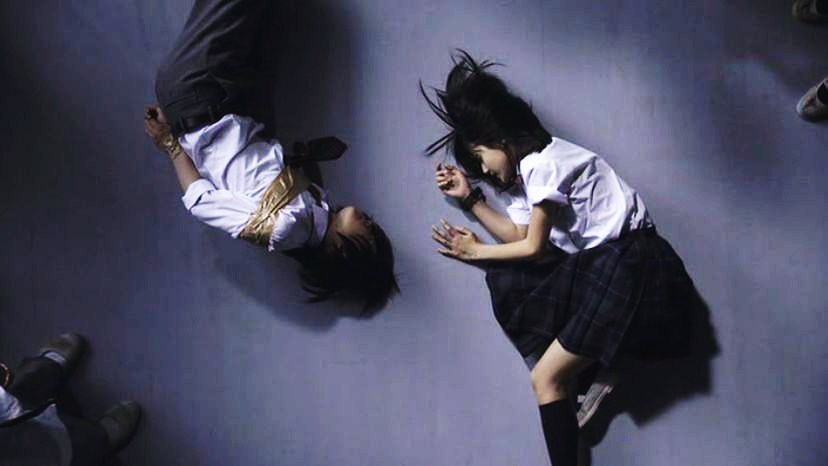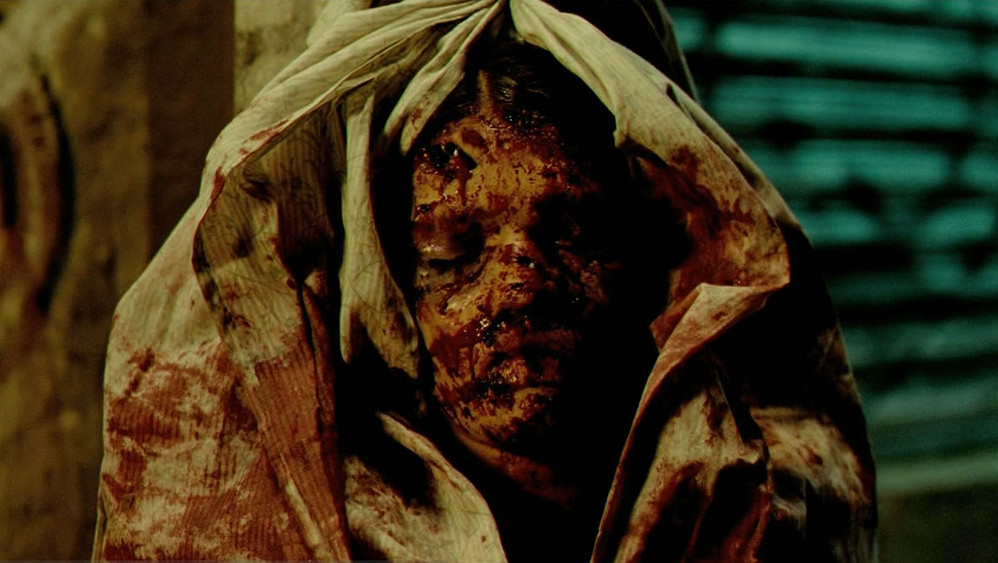7. Pontypool (Bruce McDonald, 2009)

Zombies have become such an enormous trend over the last decade that it’s difficult to work up any enthusiasm for yet another film starring the walking dead. Canadian horror film Pontypool, however, is well worth taking the time to see.
Rather than most zombie films, where the zombies are created by a virus, the “conversationalists” (writer Tony Burgess’ name for his quasi-zombies) of Pontypool spread their infection through language. As Burgess puts it:
There are three stages to this virus. The first stage is you might begin to repeat a word. Something gets stuck. And usually it’s words that are terms of endearment like sweetheart or honey.
The second stage is your language becomes scrambled and you can’t express yourself properly. The third stage you become so distraught at your condition that the only way out of the situation you feel, as an infected person, is to try and chew your way through the mouth of another person.
Pontypool follows the crew of a radio station on the night that an outbreak of the “virus” occurs. Part of what makes the film so compelling, apart from its highly original premise, is that the filmmakers elect to avoid showing the conversationalists, or any kind of gore, for as long as possible, instead building atmosphere through people calling in to the station and describing what is happening in the outside world.
8. Burning Bright (Carlos Brooks, 2010)

Burning Bright uses what is perhaps the simplest set-up for a horror film: you are trapped in your house with something that wants to kill you. In this case, “you” is Kelly (Briana Evigan), a young woman who lives with her autistic brother (Charlie Tahan) and abusive stepfather John (Garrett Dillahunt) who is trying to turn their house into a “safari ranch”. The monster is a Bengal tiger that John has purchased, that manages to get loose in the house.
The film is extraordinarily tense, as Kelly tries to keep herself and her brother safe until she can find a way out of the house. Carlos Brooks’ direction and solid performances from all the actors make Burning Bright a thrilling experience.
9. F (Johannes Roberts, 2010)

The use of children in horror films is a long-established tradition. There’s something about the innocence of a child that makes them work both as creepy monsters or sympathetic victims. In Johannes Roberts’ hoodie horror F, they are most definitely the latter.
F is in some ways a problematic film. Coming as it did amidst a climate of fear surrounding urban criminality, some would argue – and some, indeed, have argued – that it fed into the demonization of working-class youths.
While this is a valid argument, the fact remains that teenage violence does exist, and while F does portray an exaggerated version of said violence, it seems a little stupid to criticise a horror film for not adhering strictly to reality.
Regardless of its politics, F is a truly frightening film – uncompromising in its brutality, well-written, and with characters that the audience can actually care about, F is worth watching from the beginning to the shocking end.
10. Tony (Gerard Johnson, 2010)

Tony is a smart, brutal independent horror made in Dalston, London. The simple, stark look of the film is enough on its own to make Tony worth watching – far too many horror films fall down when it comes to the way they look, either being too glossy, having poor camerawork, or both. Tony manages to avoid either of those problems, with the visuals being every bit as good as the acting and the script.
The titular serial killer, played perfectly by Peter Ferdinando, is a misfit loner similar to killers such as Dennis Nilsen and Jeffery Dahmer in that his killing is a result of his failure to connect with other people.
The washed-out look of the streets Tony walks mirror the drab interior of his flat, which in turn mirror the faded, dejected landscape of his mind. Tony is that rarest of things: a social realist horror film. Any serious horror fan needs to see this at least once.
11. Confessions (Tetsuya Nakashima, 2010)

Confessions is another film that shows how frightening children can be. The adolescents in this film are violent, psychologically damaged, and every bit as complex as the adults – more so in fact, as the main characters are all children whereas the adults are relegated to the roles of bystanders or plot devices.
Even more shocking than the idea that children are capable of lethal violence, though, is Tetsuya Nakashima’s presentation of the idea that children can be legitimate targets for violence.
The central event of this film consists of an adult taking revenge on a pair of primary-school children, and part of what makes Confessions so disturbing is the very idea of children being the target of revenge – it is extremely rare for us as a society (and presumably the same holds true in Japan) to direct the same level of sadism towards children as we do towards adults.
There is an unspoken assumption that children exist in something approaching a state of grace, that they are fundamentally innocent, and Tetsuya Nakashima’s decision to turn this idea on its head is fascinating. Added to this is an excellent script and a soundtrack (by Toyohiko Kanahashi) that is almost worth the price of admission on its own.
12. We Are What We Are (Jorge Michel Grau, 2010)

What is We Are What We Are? Is it yet another cannibal shocker, a film that uses anthropophagy as the last word in extremity? No – there’s a sensitivity in the characterisation, a lightness of touch in the script, that sets this apart from a film like Cannibal Holocaust.
Is it a coming-out film? Well, there is certainly a narrative of coming out to oneself embedded within the film, but it is by no means the main focus – it’s just another example of writer/director Grau’s skill for characterisation.
Is it a horror film? That, of course, is a very important question, and of course there is a strong argument that it is – otherwise, it could hardly be on this list. But it certainly doesn’t follow the clichés of horror, and in fact most people will find it grimly compelling rather than frightening.
In fact, the “monsters” – the cannibalistic family around whom the film revolves – are by far the most interesting and sympathetic characters in the film. In truth, it’s difficult to say much about the type of film that We Are What We Are is.
All one can say with certainty is that it is not a conventional film, and that it is a must-see for anyone interested in what lies on the margins of the horror genre.
13. Nurse (Doug Aaronioski, 2013)

Replete with misogyny, gratuitous nudity and gore, Doug Aaronioski’s Nurse is an unapologetic exploitation film about a nurse who murders cheating husbands.
There are plenty of reasons to dislike the film – the stupidity of the plot, the objectification of women, and especially the fact that the lead actress speaks as if she has significant brain damage. But despite all these things, Nurse is still worth watching.
Aaronioski knows what he’s doing – he’s making a fun, dumb piece of entertainment that should be watched with one’s brain turned off – and he does it not only well but, more importantly, without pretension. The world has more intelligent, artistic films than you could shake a clapboard at, but sometimes you just need to sit back and enjoy something unashamedly lowbrow.